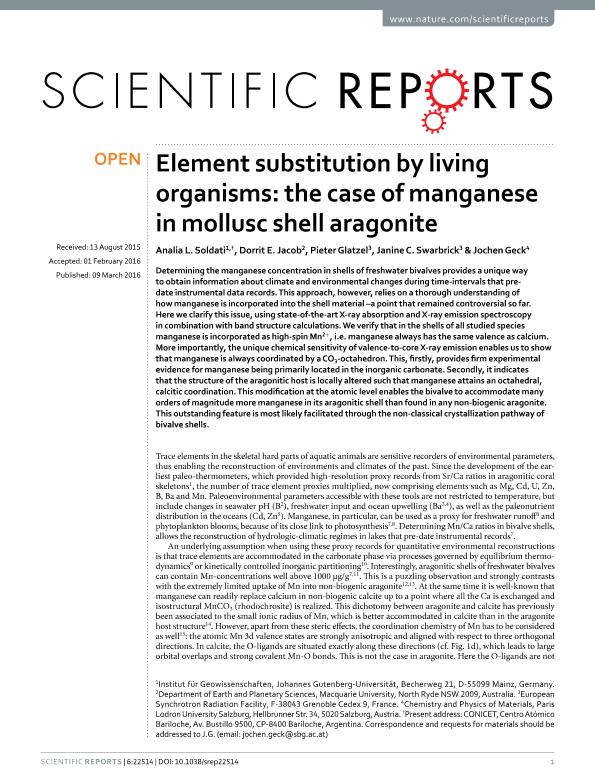Artículo
Element substitution by living organisms: The case of manganese in mollusc shell aragonite
Fecha de publicación:
03/2016
Editorial:
Nature Publishing Group
Revista:
Scientific Reports
ISSN:
2045-2322
Idioma:
Inglés
Tipo de recurso:
Artículo publicado
Clasificación temática:
Resumen
Determining the manganese concentration in shells of freshwater bivalves provides a unique way to obtain information about climate and environmental changes during time-intervals that pre-date instrumental data records. This approach, however, relies on a thorough understanding of how manganese is incorporated into the shell material-a point that remained controversial so far. Here we clarify this issue, using state-of-the-art X-ray absorption and X-ray emission spectroscopy in combination with band structure calculations. We verify that in the shells of all studied species manganese is incorporated as high-spin Mn 2+, i.e. manganese always has the same valence as calcium. More importantly, the unique chemical sensitivity of valence-to-core X-ray emission enables us to show that manganese is always coordinated by a CO 3-octahedron. This, firstly, provides firm experimental evidence for manganese being primarily located in the inorganic carbonate. Secondly, it indicates that the structure of the aragonitic host is locally altered such that manganese attains an octahedral, calcitic coordination. This modification at the atomic level enables the bivalve to accommodate many orders of magnitude more manganese in its aragonitic shell than found in any non-biogenic aragonite. This outstanding feature is most likely facilitated through the non-classical crystallization pathway of bivalve shells.
Palabras clave:
Paleoclimate
,
Trace Elements
,
Xanes
,
Microscopy
Archivos asociados
Licencia
Identificadores
Colecciones
Articulos(CCT - PATAGONIA NORTE)
Articulos de CTRO.CIENTIFICO TECNOL.CONICET - PATAGONIA NORTE
Articulos de CTRO.CIENTIFICO TECNOL.CONICET - PATAGONIA NORTE
Citación
Soldati, Analía Leticia; Jacob, Dorrit E.; Glatzel, Pieter; Swarbrick, Janine C.; Geck, Jochen; Element substitution by living organisms: The case of manganese in mollusc shell aragonite; Nature Publishing Group; Scientific Reports; 6; 3-2016; 22514-22524
Compartir
Altmétricas




